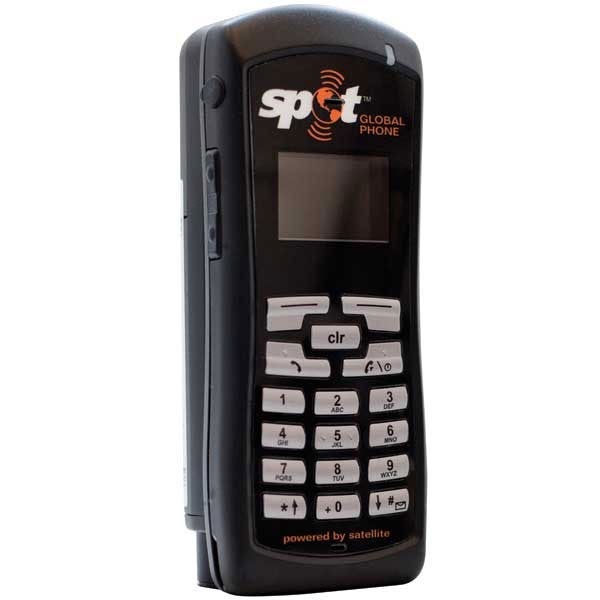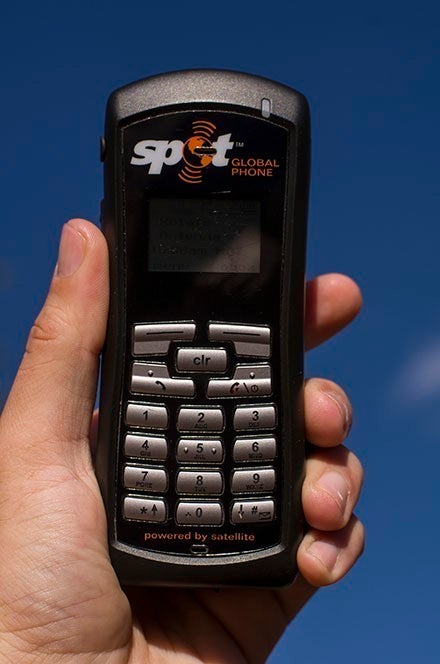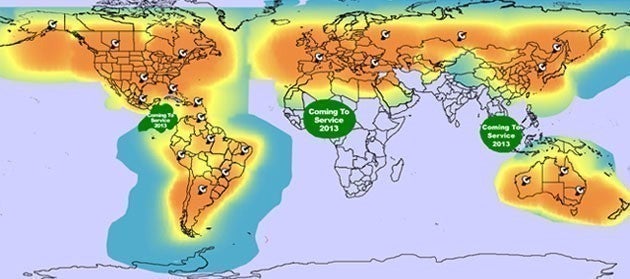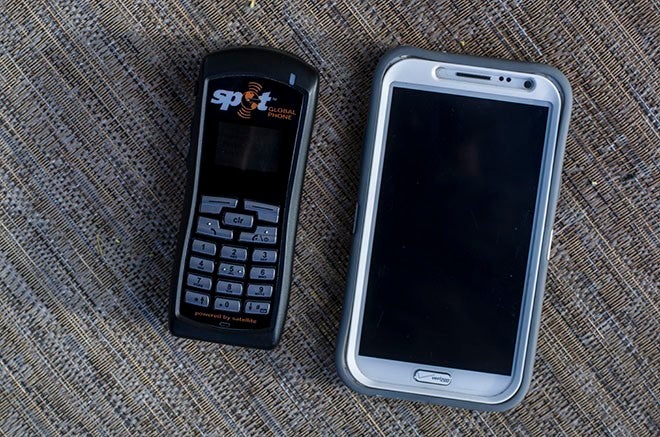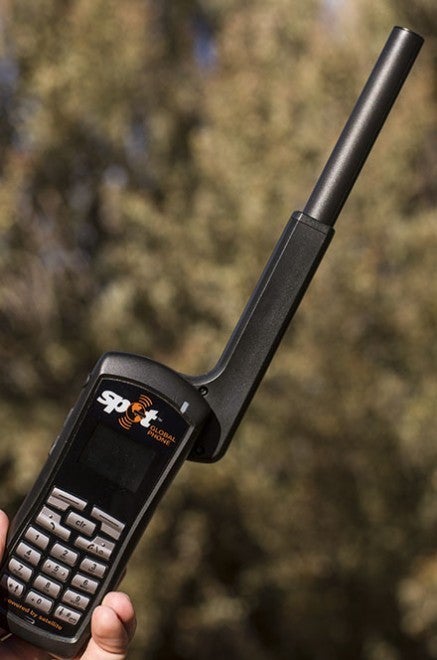When satellite phones first came out, their costs were so high as to prevent use by anyone outside military and government circles (and perhaps drug lords). Since then, they have gradually become more and more available to average consumers. I have been a satellite phone user for a number of years, and followed news of SPOT’s satellite phone with interest. It’s called the “Global Phone,” and SPOT claims it is “the ultimate easy to use, lightweight handheld satellite phone.”
Knowing my affinity for technology and past history with various satellite phones, TFB editors asked if I wanted to review the Global Phone. I said yes, and a few weeks later SPOT sent an example for me to test. I’ve been using the phone for several months – here’s what I think.
Satellite Phone Options
There are four major companies which provide satellite phone coverage to consumers – Iridium, Inmarsat, Thuraya, and Globalstar. Thuraya only covers the Middle East, while the others offer more or less global coverage. For the purposes of this article only, Thuraya is nonexistent. The SPOT Global Phone operates on the Globalstar network.
Iridium, developed by Motorola, is widely used by the US military and government and uses approximately 60 satellites in a low earth orbit (approximately 485 miles) to provide coverage anywhere on the planet. Inmarsat was originally a not-for-profit venture as part of the International Maritime Organization, itself part of the UN, but is now a private corporation utilizing 10 geosynchronous (stationary relative to the surface of the earth) satellites at an orbit of 22,240 miles above the surface of the earth, and covers almost the whole planet, with the exception of the polar regions. Globalstar was a venture between Qualcomm and Loral which is now a privately held corporation. Like Iridium, Globalstar uses dozens of low-earth-orbit (876 mile) satellites. Unlike Iridium, the Globalstar network does not cover the entire planet.
What do these differences mean?
Inmarsat
With the geosynchronous (stationary) orbit of the Inmarsat satellites, which are positioned around the Equator, if you can “see” the satellite, you can talk as long as your wallet can stand. I own an Inmarsat phone and have used it numerous times over the last few years, and have been very happy with the service quality. I have never experienced a dropped call. On the other hand, if you can’t see the satellite, you can’t make a call.
In my experience, however, it is relatively easy to get service on the Inmarsat network – though most of my travels and use of the Inmarsat have been not too far from the Equator. I should also mention that the very high altitude of the Inmarsat network can be a blessing in some situations: in my experience it is easier for the Inmarsat satellites to “look down” over high terrain or other obscuration such as canyons than satellites at lower altitudes. Although it’s not especially relevant to a lone traveler, Inmarsat has the ability to direct “beams” of higher coverage in areas seen by its satellites. This is relevant during, say, a natural disaster, when lots of people might be using satphones in the area.
Iridium
With the many fast-moving Iridium satellites orbiting around the planet at various latitudes, if you can’t currently “see” a satellite, one may very well come into view rather quickly. Therefore, if you can’t move, you might soon be able to make a call. On the other hand, there are only two Earth-based gateways which calls must be routed through, and even if you had an ideal view of the sky, you’re being handed off from satellite to satellite every 9-10 minutes. By the way, a gateway basically takes the call from the satellite realm and connects it to existing landline systems.
The hand-off from satellite to satellite isn’t always perfect, and as a result dropped calls are more frequent. Call quality is also not great, with long pauses between the time sounds are transmitted and received. I have the most time using Iridium phones, and I have experienced countless dropped calls. Overall, though, I was quite satisfied with my ability to talk to people on the other side of the planet. Plus, as mentioned previously, Iridium offers truly global coverage.
Globalstar
With the (somewhat fewer than Iridium) fast-moving Globalstar satellites, you do not have the geosynchronous advantage of a single satellite watching over you from 22,000 miles overhead, but you do have multiple satellites passing overhead frequently at a lower altitude. In addition, the Globalstar network uses over 20 regional gateways to connect satellite phone calls to landline and cell phone networks.
Unlike the 2 Iridium gateways, the Globalstar gateways do not provide global coverage. What they do provide is reduced transmission times and somewhat improved call quality. With the Iridium system, a call is bounced between several satellites and a gateway which might be on the other side of the planet. On Inmarsat, the call goes directly from the satellite to a nearby gateway.
In order to get service on the Globalstar network, you must have a view of a satellite which has a view of a nearby gateway. That said, in several months of semi-frequent use, I did not have any dropped calls with the SPOT Global Phone.
I should point out that whenever I discuss satellite phones with other people who have used them for a while, they look down their noses at Globalstar. This is due to problems encountered in the mid-2000s. Basically, some of their satellites started dying out sooner than expected, and many problems resulted. Globalstar has since launched several dozen more satellites, which they claim has improved service times and qualities. These launches took place from 2009 into the early part of this year, and appear to have fixed most of the problems that people complain about – as far as I could tell from my use of the phone.
“I Saw Gravity, I Know Satellites Die Or Run Into Stuff”
It’s important to note that both Inmarsat and Globalstar are currently or have been launching new satellites on a regular, if not extremely frequent, basis. If you spend time researching satphones, you are bound to run across articles touting one network over another from 5 or 10 years ago. Many references still live on the Web say Inmarsat has three or four satellites, and thus many terrain shadows; they now have ten (including the I-3 and I-4 series), with correspondingly fewer terrain shadows. Similarly, people complaining about Globalstar in 2007 were using different satellites than someone using Globalstar today would use. Iridium’s 66 active and dozen or so spare satellites were launched prior to 2002, but the company is planning to launch new satellites as of 2015, with the goal of replacing every satellite in their network by 2017.
Enough Already, Tell Me About The Phone
The SPOT Global Phone is indeed the smallest and lightest satellite phone I have ever used. While my Inmarsat iSatPhone Pro does fit in most of my front pants pockets, the SPOT Global Phone does so without looking ridiculous.
It was also pretty easy to set up, although I had the advantage of using a phone which had already been activated. I took it out of the box, charged the battery, and went outside to use the phone. Initially it couldn’t find a signal, but after turning it off and on, it found a signal within ten seconds. This happened most of the time when I pulled the phone out and attempted to use it, but not always. While all satphones are somewhat sensitive to antenna position (otherwise they wouldn’t have them), the Global Phone really needs the antenna to be as close to vertical as possible in order to acquire service.
The closest I came to using the Global Phone in an “emergency” was while flying a light aircraft over a remote portion of Southern Utah. There was a minor electrical fire under the instrument panel, and I elected to land at a small airport which just happened to be located directly beneath my airplane. After an inspection of the aircraft, I decided to continue on without the electrical system, planning to use the Global Phone to make periodic position reports to family at home.
Unfortunately, the Global Phone couldn’t find a signal, and I decided to stop trying after a few minutes, as I needed to focus on flying and navigating. I was able to occasionally find a signal with my cell phone, with which I sent text messages. Once I landed the plane at home and took time to work with the phone, I was able to get a signal with the Global Phone. It’s possible that I could have done so in air, but there were more important things to focus on.
During the several months I had this phone, I spent a decent amount of time using it to talk to people while on the ground. Call quality wasn’t as perfect as advertised, but it was good. It didn’t exactly sound like a cell phone, but I could understand the person on the other end and they could understand me. Over time, as I used the phone in remote areas and even while in moving vehicles, I encountered this same relatively good level of call quality. One notable exception was when some electronic voodoo apparently changed my voice into something that a friend described as “really creepy” and “a mix of Christian Bale’s Batman and a dead person.”
While I didn’t attempt to use up the claimed 4 hours of talk time per battery charge all at once, I was impressed with how much use I was able to get out of the phone over a period of several weeks without a charge. That said, I use satphones pretty sparingly – if the phone is on, it’s because I need to make a call or am expecting one. I also tend to keep satphone calls relatively short, due in part to how expensive airtime can be.
One complaint about the Global Phone would be that the power supply connector is not a standard or easily found item. I managed to keep track of the one I was sent, which is a minor miracle. However, had I misplaced it, I could not have used any other charger in my possession. In this regard, I much prefer my Intelsat phone, which uses a standard mini-USB cable to charge – this also allows me to charge the Inmarsat phone from a laptop battery if necessary, unlike the Global Phone, which requires a power outlet. It struck me as odd that a new phone would use a relatively old charging method.
While the Global Phone does use a standard US telephone number, which is handy and easier for Americans to remember, all my calls came through as “unavailable” with no associated number, which might keep a family member or friend from answering if I needed to get in touch with them. The Global Phone also does not offer a two-way texting feature, which is offered by my Inmarsat. Also, the Inmarsat will tell me my exact position at any time, and allow me to text that info to anyone, while the Global Phone only tells you your location while you are in a call.
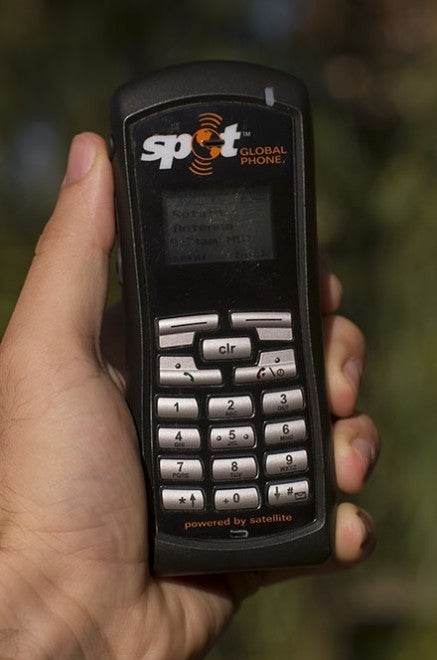
The screen brightness and design reminded me of a ten-year-old cell phone. The screen backlight is on in this photo.
The screen is fairly small and not exceptionally easy to read in bright sunlight, especially due to its secondary purpose as a signal mirror. However, it seems adequately durable, as does the rest of the phone. I tossed it in an Arc’teryx Drypack 70 during the Arc’teryx/Nemo Equipment Red Rock Challenge along with a bunch of other outdoor gear – not in a case, just the phone by itself. It survived with full functionality (perhaps due to the fact that it was in a very, very expensive pack) and only a few light scratches.
Service is available in a variety of quantities from the 10 minute/$25 per month “HALP LEGS CHEWED OFF BY BEAR SEND HELICOPTER” plan to the unlimited, $150 per month “I run my cartel’s daily operations from various jungle locations” plan. If you go over these amounts, except of course for the unlimited plan, you’ll pay per minute, between $1 and $2 depending on the plan. Although there are monthly and yearly plans, a 12 month contract is required, and the minutes/dollars per month really don’t change whether you pay up front or per month. One more thing to note is that for new activations until the end of this year, there is a “double minutes” bonus available for the first year on all plans, at the same price.
One significant benefit of the Global Phone over the Inmarsat IsatPhone Pro is that the cheapest, emergency-only SPOT plan (good anywhere SPOT has service, see above) costs about half as much as what you’re likely to find a North America-inclusive Inmarsat plan for.
I found myself thinking that the Global Phone seemed a lot like the cell phones I used ten years ago, albeit slightly larger and with a big antenna. I pulled the battery (which was labeled Globalstar, not SPOT) and saw that the model number was GSP-1700. I Googled “GSP-1700” and found that this model was announced in 2006. It’s not terribly surprising, then, that it struck me as similar to a ten-year-old cell phone.
It would appear that the Global Phone is a repackaged GSP-1700, which is still sold by Globalstar under that model number for approximately the same price. The original list price for the GSP-1700 appears to have been $999. If my interpretation of the label inside the battery compartment is correct, my particular phone was made in July of 2009. It is therefore a bit of a stretch for SPOT to have introduced the Global Phone in May of this year as “new.”
That much is as factual as I can get; what follows is a bit of fact and a bit of supposition. Globalstar introduced a new phone at the end of 2006; their satellite network essentially falls apart around the same time. Presumably, they have a lot of phones sitting around unsold. Globalstar then launches a new satellite network from 2010 to 2013. Three months after the last satellite is launched, which coincides with that last satellite coming online, SPOT (a Globalstar subsidiary) announces the “new” Global Phone, which appears to be just a relabeled version of the phones they must have had sitting around for years. I guess they didn’t have much choice from a business perspective, but their claim that the GSP-1700/Global Phone is new (and price it relatively high) just rubs me the wrong way.
Overall, I was somewhat satisfied with the performance of the SPOT Global phone; however, I did not pay for it, and SPOT is asking $499 for the phone, plus service. If the price was under $250, perhaps I could see buying a SPOT Global Phone. However, considering that I paid essentially the same price ($550) for the Inmarsat iSatPhone Pro (introduced in 2011), which offers a greater coverage area, a more flexible charging system, and two-way texting – I really cannot see myself buying a SPOT Global Phone at the current price.
 Your Privacy Choices
Your Privacy Choices
